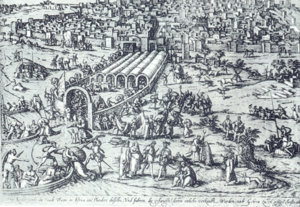Conquest of Tunis (1535)
| Conquest of Tunis | |||||||||
|---|---|---|---|---|---|---|---|---|---|
| Part of the Ottoman–Habsburg wars and the Ottoman–Portuguese conflicts |
|||||||||
 Attack on La Goletta, with Tunis in the background.  Entry of Charles V, Holy Roman Emperor into Tunis in 1535. |
|||||||||
|
|||||||||
| Belligerents | |||||||||
|
|
|
||||||||
| Commanders and leaders | |||||||||
|
|
|
||||||||
| Strength | |||||||||
|
Total men: 60,000 Total ships: 398 |
|
||||||||
| Casualties and losses | |||||||||
| Unknown: Many fell to dysentery | Unknown | ||||||||
The Conquest of Tunis in 1535 was an attack on Tunis, then under the control of the Ottoman Empire, by the Habsburg Empire of Charles V and its allies.
In 1533, Suleiman the Magnificent ordered Hayreddin Barbarossa, whom he had summoned from Algiers, to build a large war fleet in the arsenal of Constantinople. Altogether 70 galleys were built during the winter of 1533–1534, manned by slave oarsmen, including 2,000 Jewish ones. With this fleet, Barbarossa conducted aggressive raids along the coast of Italy, until he conquered Tunis on 16 August 1534, ousting the local ruler, theretofore subservient to the Spanish, Muley Hasan. Barbarossa thus established a strong naval base in Tunis, which could be used for raids in the region, and on nearby Malta.
Charles V, one of the most powerful men in Europe at the time, assembled a large army of some 30,000 soldiers, 74 galleys (rowed by chained Protestants shipped in from Antwerp), 300 sailing ships, the Santa Anna and Portuguese galleon São João Baptista, also known as Botafogo and the most powerful ship in the world at the time, with 366 bronze cannons to drive the Ottomans from the region. The expense involved for Charles V was considerable, and at 1,000,000 ducats was on par with the cost of Charles' campaign against Suleiman on the Danube. Unexpectedly, the funding of the conquest of Tunis came from the galleons sailing in from the New World, in the form of a 2 million gold ducats treasure extracted by Francisco Pizarro in exchange for his releasing of the Inca king Atahualpa (whom he nevertheless executed on 29 August 1533).
...
Wikipedia
